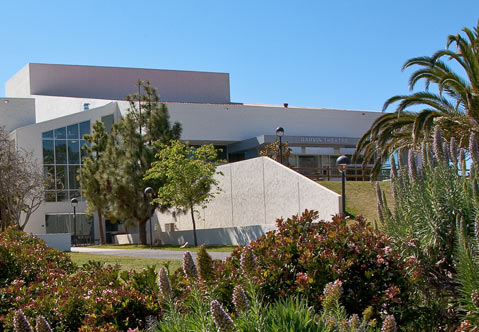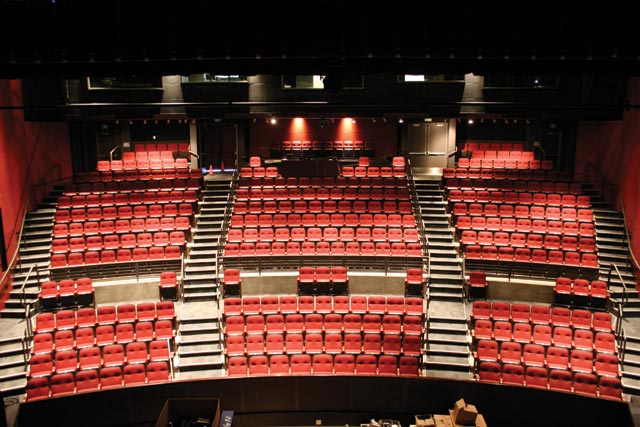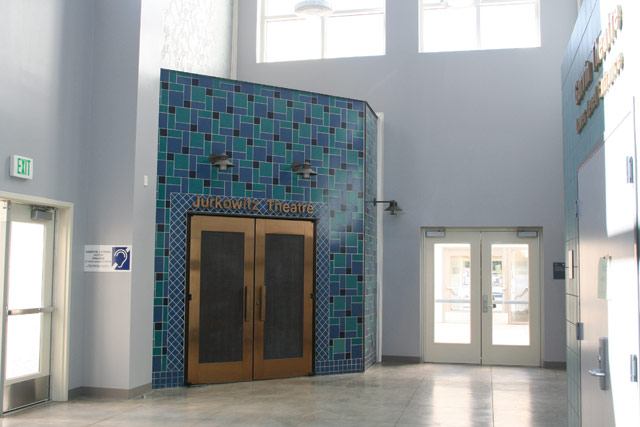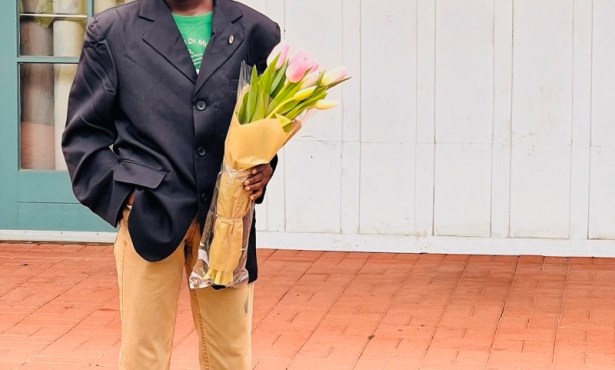SBCC’s New Theater
The Garvin Theater Gets a $24-Million Makeover

Who can forget the fall of 2008? The international financial system nearly came crashing down. A suddenly famous governor of Alaska regaled us with her literal and figurative views of Russia. And Santa Barbarans seeking a distraction from the discord flocked to the Garvin Theatre to see the musical revue The World Goes ’Round.
Nearly four years later, we’re enduring another divisive presidential campaign and still waiting for the world’s economy to recover. But at least one wait is over. The Garvin, which was closed for extensive renovation shortly after Barack Obama was elected, is about to reopen.
Its $24-million remodeling project complete, the theater complex on the West Campus of Santa Barbara City College will welcome back audiences beginning July 11. That evening, the Santa Barbara City College Theatre Group will open its new season with the brilliantly irreverent Broadway musical Avenue Q.
While a long list of upgrades will make the venue a more pleasant place to be for audiences and artists alike, longtime patrons need not brace themselves to be startled. A new lobby to the theater’s side will be the most noticeable change, along with more and better washrooms, much improved wheelchair access, and sturdy handrails that will allow patrons to more easily make their way down the stairs and into their seats.

Beyond that, the changes — including new stage lighting and sound systems — are mostly behind the scenes.
“People would say to us, ‘We love the Garvin. Don’t change it,’” said Katie Laris, who, with R. Michael Gros, serves as co-chair of the college’s theater department. “So it was important to us to preserve the building’s original character.”
Serving Two Revolutions
That isn’t to say it’s a historic structure. The Garvin, which consists of a 384-seat auditorium (down from 400 seats in the old configuration) and the 100-seat Jurkowitz Theatre, was built in 1977. No doubt more than a few people wonder why such a relatively new building would require such a major rehaul.
The answer can be found in two huge shifts that have taken place since the late 1970s: The computer revolution and the Americans with Disabilities Act. The latter law, signed into law by the first President Bush in 1990, mandated that people with disabilities must have full access to all public facilities, such as theaters.
The law meant that, as buildings were constructed or remodeled, accommodations such as wheelchair access had to be included in the upgrade. “This was a societal change, and we had a moral and legal responsibility to comply with it,” said Gros.
At the same time, backstage technology was rapidly evolving. Computer systems were developed to control everything from designing lights to changing sets, and SBCC’s theater arts students needed such equipment if they were to receive training that would equip them for real-world jobs.
These disparate needs were on the minds of City College officials a decade or so ago, when, as emeritus theater professor and Avenue Q director Rick Mokler recalled, “Someone brought it to our attention that there was money at the state level for ADA compliance of structures such as ours.”
They put together a proposal and were awarded a bit more than $11 million. The rest of the needed money became available when Santa Barbara voters passed Bond Measure V in June 2008. Six months after that ballot, following a few holiday concerts put on by the music department, the Garvin closed its doors, and the crews went to work.
Process, Patience, and a New Foundation
Not unlike a satisfying play, the process had a sense of inevitability — everyone knew how it would end — but there were surprises along the way. Needless to say, not all of them were pleasant.
The biggest one came early on, when workers began burrowing under the building to ensure there was proper support for a new proscenium. Funny story: It turns out there wasn’t.
“They thought they were going to anchor to rock, but they kept not finding solid rock,” Gros recalled. “They found the foundation of the Garvin was built upon rubble. It had been a dump site. It wasn’t solid and stable. They had to dig under the existing structure and put in foundation support to meet the earthquake code,” which was toughened up after the 1994 Northridge quake.
Given that unpleasant discovery, it is somewhat miraculous that the renovation came in only $2 million over the original $22-million estimate. (That certainly compares favorably to the cost overruns on the Granada renovation.)

Nevertheless, Laris and her colleagues have gotten accustomed to answering an understandable question: How can we afford this sort of project at a time when state money for education is so tight?
“The answer is this has been in motion for a long, long time,” Mokler said, going on to say he doubts they would have gotten funding for it today. “We were one of the last projects [approved before the economy tanked]. Measure V was great. It allowed us to do this.”
“It is appropriate that the community would support this project,” added Pamela Shaw, director of costumes and makeup, who proudly showed off the improved dressing rooms and costume shop. “We draw audiences from all around the area and serve the community in a very visible way.”
Multiple Muses, Plus an Appreciative Audience
That includes music fans, as well as theatergoers: The Garvin also serves as the college’s concert hall. In his redesign, Los Angeles–based theater designer John Sergio Fisher kept in mind the need to serve both art forms: There is a new orchestra shell for classical concerts, and sliding panels to either side of the stage will allow the acoustics to be adjusted to serve either music or the spoken word.
However, the facility’s primary tenant is the Theatre Group — an organization that traces its roots back to the 1940s — and its loyal audience has been patiently waiting for its return.
“We already have over 1,000 subscribers,” Gros noted, citing pent-up demand. “We had zero a month ago.” The company is aiming for 1,100 this season, which would be not far off its peak of 1,300 subscribers for the 2007-08 season.
Those positive numbers are particularly welcome, since the Theatre Group needs the money. While its salaries are paid for and facilities are provided by the college, revenue must be collected to pay for all production expenses — everything from royalties to the cost of renting puppets (not a small item for Avenue Q, which, for those who haven’t seen it, is a sweet but sassy satire of Sesame Street).
“The puppets are child-like, but they’re going through adult experiences,” Mokler noted. “So there’s an innocence that’s coupled with experience. When a puppet puts their hand on another puppet’s face, it can be quite lovely. Or even erotic.”
As that comment suggests, Mokler and his colleagues have not chosen to play it safe with their first season back.
Ambitious Large Plays for Adults
Both Avenue Q and the second show in the season, Tracy Letts’s August: Osage County, are Tony Award–winning Broadway hits. But neither can be called delicate or demure, and their sensibility is tragicomic — more HBO than CBS. Both expertly mix pathos with laughs, and neither shies away from touchy issues.
Both are also big shows. “Large casts is something that we’re drawn to,” Laris said. “They offer more opportunities for our actor base. We don’t have the financial disincentives to do large-cast shows [that professional theaters do].”
That raises a somewhat touchy question. While it’s hard to fault the Theatre Group for ambition or scope (the season also includes the Noel Coward classic Present Laughter in March, and a new Steven Dietz play, Becky’s New Car, in April), its heavy reliance on nonprofessional actors makes it an open question whether it can truly pull off work this complex and multifaceted.
During its first decades, when it was part of the continuing-education department of what was then called Santa Barbara Junior College, the Theatre Group was basically a community troupe. With the opening of the Garvin in the late 1970s (prior to that, performances were at the Lobero or Alhecama theaters), it merged with the college’s theater program and became a hybrid — its productions feature area actors, students, and the occasional professional.
It’s a very different model than that of PCPA Theaterfest in Santa Maria, which Gros used to run. That company, also housed at a two-year college, has a faculty of working actors who take the lead roles in most of the productions. This setup has its drawbacks, but it also ensures a certain level of acting quality is consistently maintained.
Mokler said he’d be happy to have more professionals in the casts; it’s a matter of money. “We’ll be stuffing the programs with the campaign for guest artists,” he said.
For Avenue Q, the five-person band (led by David Potter) will be made up of professional musicians, and the cast will include two pros — including one who will be making a homecoming of sorts. New York–based actor Ryan Murray, who plays the role of Princeton, is a Santa Barbara City College alum. Mokler reports he was a backup singer in the summer 1999 production of Buddy: The Buddy Holly Story at the Garvin.
“Our students will be working side by side with him,” Laris noted, “which will give them a wonderful model of where they can go from here.”
Thanks to such invaluable experiences, as well as new state-of-the-art equipment, they’ll be getting a solid foundation in their craft. And they’ll be doing so in a theater that finally can boast a solid foundation of its own.
4•1•1
Avenue Q previews July 11 and 12 at 7 p.m. and runs July 13-28, Thursday-Saturday at 7:30 p.m. and Sunday at 2 p.m. Call the Garvin Theatre box office at 965-5935 or go to theatregroupsbcc.com for reservations and information.



